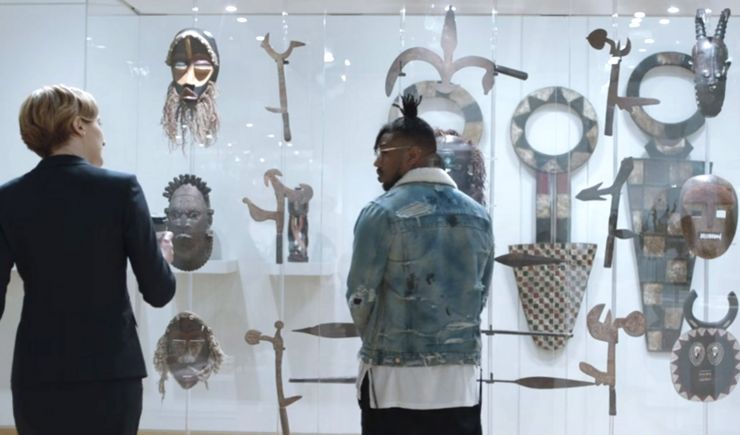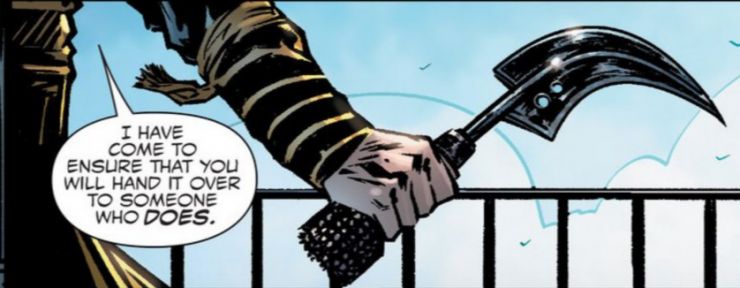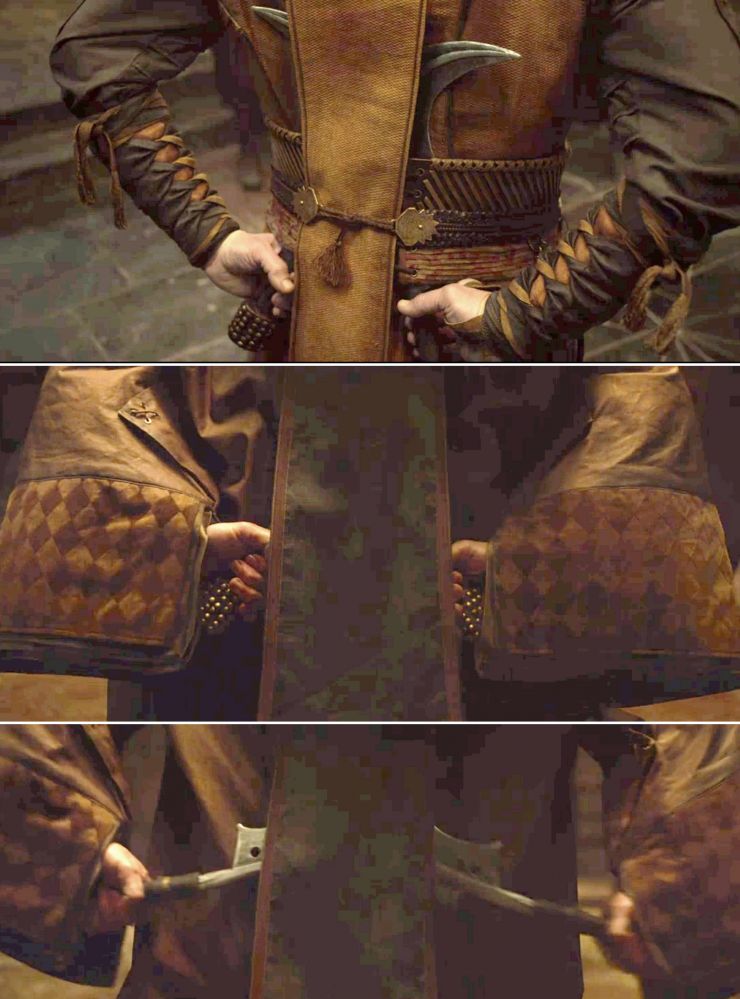Inauthentic Throwing Knife, Pere or Mokoongo
In the style of the Kreish (Kresh / Kreisch / Kreich) / Adio / Bongo / Sere, South Sudan / Central African Republic
Sheet metal, wood, copper
1990s
Knowing it was a low-end reproduction, I acquired this knife years ago because it made me smile for its attempt at resembling my favorite throwing knife, a Kreish. I try to only publish high-end reproductions in this section, however, I have an old gripe with the movie Black Panther that makes this replica relevant.
In general, Black Panther was a huge success that cast an African as a superhero, and reinforced the importance of Oakland’s role in the history of black resistance. Visually, the movie was quite impressive, not only for the special effects, but also for the way traditional African designs, patterns, textiles, adornments, weapons, body modifications, and general aesthetics were woven into the visual landscape throughout the film.
But one detail has always bothered me. When Michael B. Jordan walks into the African art section of the “Museum of Great Britain” in London, he is surrounded by inauthentic objects.

Clearly modeled after the British Museum (below), the museum in Black Panther features a showcase in the center of the room that displays many knives (above).

Some of the African objects in the Black Panther museum are good enough… they’re recent creations, but strong representations of traditional designs, like the Bobo mask, the Nafana Bedu mask, and the Kuba textiles. But the knives in the showcase are low-end reproductions, just like the Kreish blade shown here.
Typical of reproduction knives that have been coming out of Africa since the 1990s, the knives in the movie and the Kreish shown here share many characteristics: they are cut from a thin sheet of metal, their outlines are awkward and unbalanced, their overall size and/or the size of certain elements is incorrect, their handles are composed of the wrong materials and wrong design, the corrosion on the surfaces is fresh and clearly induced, and they deviate wildly from the aesthetics of the cultures that they imitate. Demonstrating that these reproductions were not made by the correct culture, sometimes elements of different cultures are combined into a single knife, and sometimes, invented designs appear (as in this Kreish knife, on the right side of the wing).
Going back to Black Panther, the knives in their museum serve to show that African knives exhibit unusual and ingenious shapes, but they don’t convey the incredible skill and artistic talent of traditional African blacksmiths. While I am pleased to see African knives anywhere, Black Panther falls short.
A colleague of mine told me many times that the producers of Black Panther went with low-end reproductions because nobody other than me would notice or care, and that is quite possibly true. However, consider the attention to detail given to Mangbetu knives in Doctor Strange.
In the illustrated Doctor Strange, there was a frame where he wields a Mangbetu blade with brass tacks on the handle:

In the Doctor Strange movie, there is a brief moment in the beginning, where he pulls two Mangbetu knives from his back and uses them with force. The scene happens so fast, it’s difficult to even get a good look at the knives. However, they are carefully crafted reproductions that correctly represent the authentic style.

For me, the two seconds of authenticity in Doctor Strange outweigh the two minutes of exposure in Black Panther, especially because of the misattributions in Black Panther. While Doctor Strange doesn’t mention an African source at all, Black Panther misrepresents cultures – for example, labeling a mask from Burkina Faso as coming from the “Bobo Ashanti tribe, present day Ghana” (a Jamaican culture), and placing all of the central African knives in the “West African Exhibit” section of the museum.
With the backing of Marvel Comics and Walt Disney Studios, surely Black Panther had a colossal budget that could have afforded the rental or purchase of authentic art to place in their museum, and also cover the cost of researching the cultures that they were representing. Alternatively, they could have also purchased contemporary knives from the correct places of origin (Central African Republic, Republic of Congo, Democratic Republic of Congo) which would have diverted funds to today’s talented African blacksmiths. But instead they chose low-end reproductions, probably because – as my colleague asserted – nobody besides me would notice or care. And that’s most likely the truth. Just today, I watched a prominent sports journalist, J.A. Adande, proudly conduct a nationally-broadcast video interview in front of a group of inauthentic African art pieces, and I don’t think anyone will notice or care, and he’ll likely be back tomorrow with more of the same.
But still, I salute Black Panther for bringing so many aspects of African culture so energetically to the fore, save that one glaring error.
RIP Chadwick Boseman.
21 in :: 53.5 cm
InventoryID #13-1568
Not For Sale



